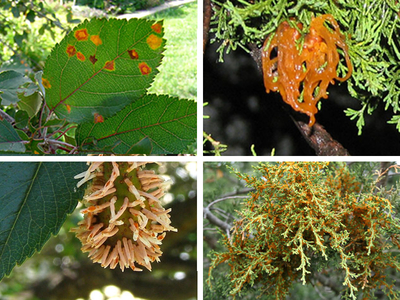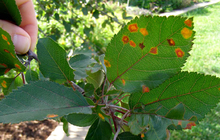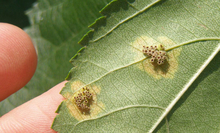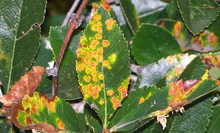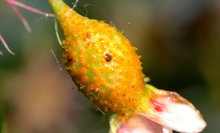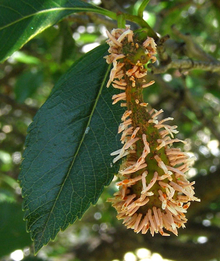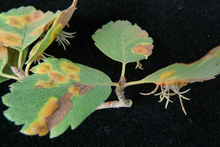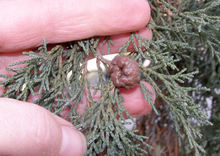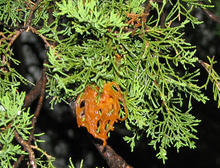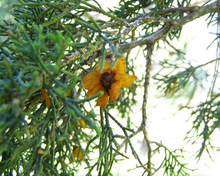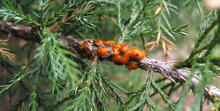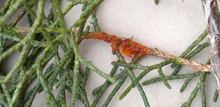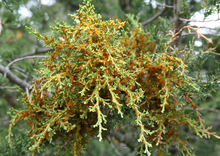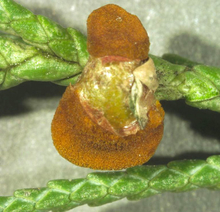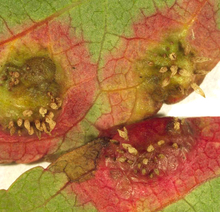Quick facts
- Cedar-apple rust and related rust fungi need plants from two plant families to complete their life cycle.
- These fungi rarely cause serious damage to their hosts and do not require management in most cases.
- This disease can cause damage to leaves and fruit of very susceptible apple varieties but is only a minor problem on resistant or partially resistant trees.
- Do not plant eastern red cedar and juniper within a few hundred yards of apples, hawthorns, and other plants from the Rosaceae family.
- Disease-resistant varieties are available for some plants.
How do cedar apple rust and related rust fungi survive and spread?
Although cedar-apple rust is the most well-known rust fungi, four different rust fungi cause similar diseases on the same types of trees in Minnesota.
All four require plants from two different families to complete their life cycles: one plant from the Cupressaceae family (red cedar, juniper) and the other from the Rosaceae family (crabapple, hawthorn, serviceberry, etc.).
These four related rust diseases have very similar life cycles and biology.
- Cedar-apple rust and related rust fungi over-winter in infected branches and galls on juniper and red cedar trees.
- In wet, spring weather, the galls produce orange, gummy, fungal growths that release spores.
- During dry spring weather, the orange, gummy structures shrivel and dry.
- Galls can rehydrate and dry out several times in one season in response to weather conditions.
- Once the weather becomes consistently warm and dry, spores are no longer produced on infected junipers or red cedar trees.
- After one season of spore release, galls of cedar-apple rust and hawthorn rust die and fall off the tree.
- Cankers of quince rust and witches' broom of juniper broom rust go dormant but may survive for multiple years, releasing new spores each spring.
- Spores produced on infected junipers and red cedar trees are carried by wind to susceptible apple, hawthorn or other plants in the Rosaceae family.
- These spores can infect trees over a mile away.
- If leaves and fruit are wet, spores can start new infections.
- Leaf spot and fruit infections grow slowly over the summer.
- Powdery yellow, orange or chestnut-brown spores are released from infected leaves and fruit mid to late summer.
- These spores cannot infect trees in the Rosaceae family. They must be carried by wind to start new infections on young needles and shoots of juniper or red cedar trees.
- It takes up to two years for galls to form on the juniper or red cedar tree.
How to identify rust
These diseases require plants from two different families to complete their life cycles. Symptoms are very different on each type of plant.
Cedar-apple rust
- Disease is most common on apple and crabapple. It occurs occasionally on hawthorn.
- Leaf spots are first yellow then turn bright orange-red, often with a bright red border.
- Small, raised, black dots form in the center of leaf spots on the upper leaf surface when the leaf spots mature.
- Very short (less than 1/10th inch), finger-like fungal tubes stick out from the lower surface of the leaf, directly below leaf spots.
- The fungal tubes appear fringed when they open at the tip to release yellow to orange, powdery spores.
- Rarely, green to brown irregular spots with black dots form on the fruit surface. Fruit spots do not extend deep into the fruit.
Hawthorn rust
- Disease is most common on hawthorn, apple and crabapple. It occurs occasionally on serviceberry, quince and pear.
- Leaf spots are yellow to orange. Raised, black dots form in the center of the spots on the upper leaf surface as they mature.
- White, finger-like, fungal tubes (up to 1/8th inch long) stick out from the underside of leaf spots.
- When infection is severe on hawthorn, leaves turn completely yellow and fall prematurely.
- Infection of green stems occurs occasionally and can result in thick, deformed growth of stems. This can cause shoot death when severe.
- Rarely found are orange to rust-colored, spore-filled blisters on the fruit surface.
Quince rust
- Disease occurs in over 480 species of Rosaceae family including serviceberry, chokeberry, hawthorn, apple, crabapple, cotoneaster, pear and mountain ash.
- White, finger-like fungal tubes develop all over fruit and stick out up to 1/8 inch.
- Tubes rip open at the tip to release powdery, bright orange spores.
- Leaves are often unaffected. A few yellow spots may be found on leaves.
- Infected areas of stems bulge to become elongated and distorted.
Juniper broom rust
- Disease affects serviceberry, apple and crabapple, hawthorn and mountain ash.
- Leaf spots are small, yellow, slightly raised and may have a red border.
- Raised, gummy, yellow droplets form in the center of leaf spots and eventually turn into raised, black dots.
- In highly susceptible hosts, leaf tissue around the leaf spot dies. The spot then turns brown (with a red border) and expands from the infection point to the leaf edges in a wedge shape.
- Infected leaf veins cause the leaf to curl and become distorted.
- Small, yellow spots with red borders are found on green stems, leaf petioles (leafstalks) and leaf veins.
- Finger-like tubes develop on leaf petioles (leafstalks) and stems and occasionally develop on upper and lower sides of leaf veins.
Cedar-apple rust
- Disease is most common on Eastern red cedar (Juniperus virginiana) and Rocky Mountain juniper (J. scopulorum).
Disease occurs occasionally on Chinese juniper (J. chinensis), creeping juniper and low juniper (J. communis var. depressa). - In fall, round, woody galls can be found on twigs and small branches. These galls are greenish-brown and up to 2 inches in diameter.
- In wet spring weather, these galls produce orange, gummy, tentacle-like projections that are 1/2 to 3/4 inch long.
- When dry, the gummy orange structures shrivel to a dry, reddish-brown. Galls can dry and rehydrate several times in one spring.
Hawthorn rust
- Disease is most common on Eastern red cedar (J. virginiana) and Rocky Mountain juniper (J. scopulorum).
- Disease occurs occasionally on Chinese Juniper (J. chinensis), creeping juniper (J. horizontalis), low juniper (J. communis var. depressa) and Savin juniper (J. sabina).
- Small, reddish-brown, woody galls form along needles and stems. These galls can be round or irregularly shaped, from 1/10th inch to just over 1/2 inch in size (smaller than cedar-apple rust galls).
- In spring, bright orange, gummy horns form. These horns have straight, blunt fingers that are shorter and fatter than cedar-apple rust galls.
Quince rust
- Disease occurs on Eastern red cedar (J. virginiana), common juniper (J. communis), creeping juniper (J. horizontalis), Rocky Mountain juniper (J. scopulorum), and Savin juniper (J. sabina).
- Branches and twigs swell from infection.
- Later, these infected areas become elongated and their bark begins to peel.
- In spring, small, orange, gummy blobs come out of swollen areas and cracks along infected branches.
Juniper broom rust
- Disease occurs on creeping juniper (J. horizontalis), Eastern red cedar (J. virginiana), and Rocky Mountain juniper (J. scopulorum).
- Round clumps of foliage can be seen anywhere in the tree canopy.
- These clumps are clusters of many small branches called witches’ brooms.
Swollen, elongated areas with rough, cracked bark can be seen on infected branches without witches' brooms. - Orange jelly forms on needles and from cracks in infected bark during wet spring weather.
- Brooms usually die when small but a few survive and may reach 20 to 24 inches in diameter.
Japanese apple rust is caused by Gymnosporangium yamadae, a fungus native to Asia. While this disease has been found in the Eastern U.S., it has not been identified in Minnesota.
Like other Gymnosporangium rusts, this exotic disease spends part of its life on apples or crabapples and the other part on Chinese (J. chinensis) and flaky juniper (J. squamata).
- Produces round, woody galls on the branches of Juniper (similar to cedar-apple rust).
- In spring, these galls produce orange, gummy projections.
- These projections stick out like rubbery shelves but do not dangle like the horns on Cedar-apple rust galls.
- On apple trees, leaf spots are bright red with a pale cream to white center.
- Infection on apple fruit is rare.
- Long, finger-like, fungal-spore-producing structures come out of the underside of leaf spots in mid to late summer.
- These structures produce and release chestnut-brown, powdery spores.
Suspected cases of Japanese apple rust should be reported to the Minnesota Department of Agriculture's "Report a Pest" at 1-888-545-6684 or reportapest@state.mn.us.
Reviewed in 2024


